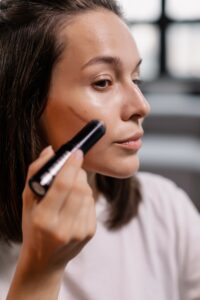A Beginner’s Guide to Sculpting Your Face

Contouring has become a popular makeup technique in recent years, thanks in part to social media and celebrity makeup artists who have made it a staple in their beauty routines. It is a technique that involves using makeup products to sculpt and define facial features, creating the illusion of a more defined bone structure and a slimmer face. In this article, we will explore what contouring is, how it works, and some tips for achieving the perfect contour.
What is contouring?
Contouring is a makeup technique that involves using a combination of darker and lighter shades of makeup to create the illusion of a more defined bone structure. The darker shades are used to create shadows, while the lighter shades are used to highlight and bring forward certain features. This creates a more sculpted and defined look, and can be used to enhance or minimize certain facial features.
How does contouring work?
Contouring works by creating the illusion of shadows and highlights on the face. The darker shades are used to create shadows, which make certain areas of the face appear smaller and more defined. The lighter shades, on the other hand, are used to highlight and bring forward certain features, such as the cheekbones, brow bone, and bridge of the nose.
To contour the face, you will need a contour product, which is typically a cream or powder that is one or two shades darker than your skin tone, as well as a highlight product, which is typically a cream or powder that is one or two shades lighter than your skin tone. You will also need a makeup brush or sponge to apply the products.
The first step in contouring is to identify the areas of the face that you want to contour. This can include the hollows of the cheeks, the temples, the jawline, and the sides of the nose. Once you have identified these areas, you can begin applying the contour product with a brush or sponge, blending it outwards to create a seamless and natural-looking shadow.
Next, you will apply the highlight product to the high points of the face, such as the cheekbones, brow bone, and bridge of the nose. This will help to bring these features forward and create a more sculpted look. Be sure to blend the highlight product carefully, as it can easily look harsh or streaky if not blended properly.
Finally, you can set your contour and highlight with a setting powder, which will help to keep your makeup in place and prevent it from smudging or fading throughout the day.

Tips for achieving the perfect contour:
Choose the right products:
When it comes to contouring, it’s important to choose the right products for your skin type and tone. If you have dry skin, you may want to opt for a cream contour product, while those with oily skin may prefer a powder formula. Be sure to choose a shade that is one or two shades darker than your skin tone for the most natural-looking result.
Use the right tools:
The tools you use to apply your contour and highlight products can make a big difference in the final result. Use a brush or sponge that is specifically designed for contouring, and be sure to blend carefully to avoid any harsh lines or streaks.
Practice makes perfect:
Contouring can take some practice to master, so don’t be discouraged if your first attempts don’t turn out perfectly. Keep practicing and experimenting with different products and techniques until you find what works best for you.
Be subtle:
While a dramatic contour can look stunning for a special occasion, it’s important to remember that less is often more when it comes to everyday makeup. Be subtle with your contouring and focus on enhancing your natural features rather than completely transforming your face.
In conclusion, contouring is a makeup technique that can help to enhance and define your facial

